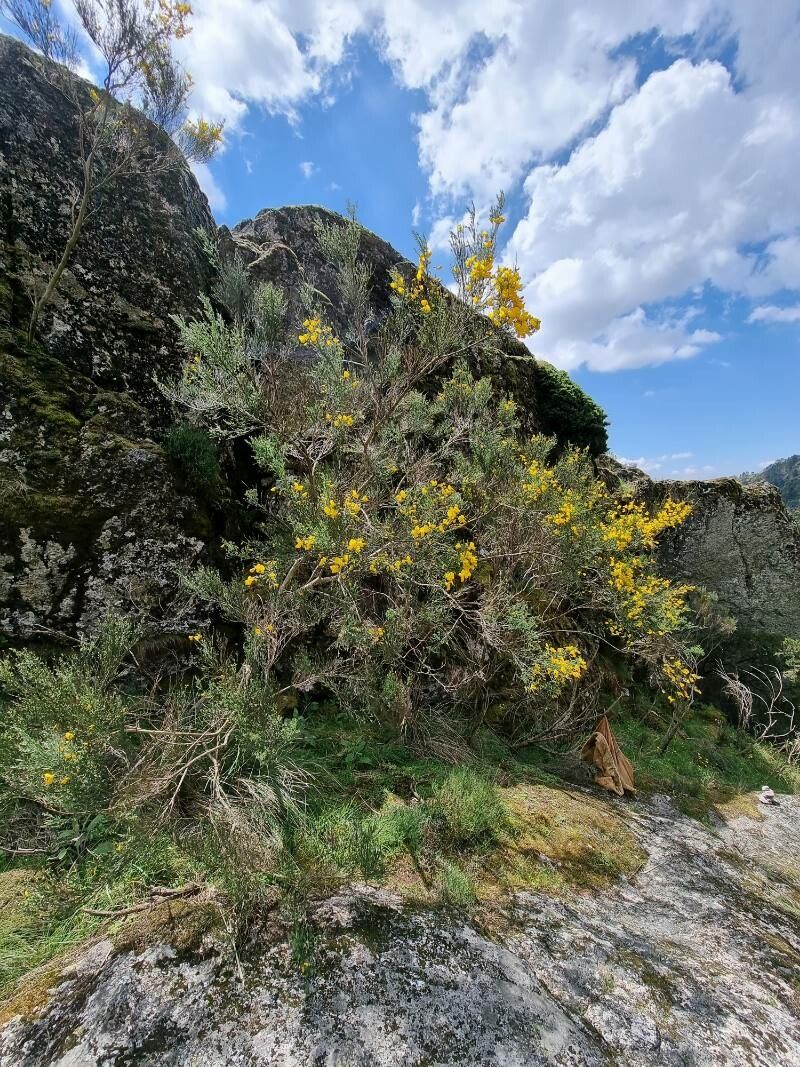Feathered Broom
cytisus striatus
Also known as: ["Feather Broom","Thinleaf Broom"]
Overview
A deciduous shrub native to western North America, known for its slender stems and yellow flowers.
Benefits & Perks
["drought tolerant","wildlife attractant (bees, butterflies, birds)","low maintenance"]
Botanical Classification
| Phylum: | Magnoliophyta |
| Class: | Magnoliopsida |
| Order: | Fabales |
| Family: | Fabaceae |
| Genus: | Cytisus |
| Botanical Name: | Cytisus striatus |
Plant Characteristics
Basic Information
- Category: Shrubs
- Suitable Location: outdoor garden bed in open, sunny area
- Suitable For:
- Is Weed: No
- Allergenicity: low
Environmental Needs
- Climate: {"temperatureRange":"–10–35°C"}
- Hardiness: {"zones":"6–9"}
- Misting: rarely required
- Drainage: Fast-draining to prevent root rot.
- Soil Type: Well-draining, sandy loam with some organic matter.
Maintenance Level
- Maintenance Level: low
- Toughness Level: high
- Pruning Frequency: Annually, after flowering; light pruning can be done as needed.
- Pruning Intensity: Moderate; remove up to one-third of old growth to rejuvenate.
Care Details
Ideal Sunlight Coverage:
Full sun (6–8 hours/day); tolerates partial shade but blooms best in direct light.
Sunlight Tolerance Tips:
Acclimate gradually if moving from shade to sun; protect from intense midday sun in hot climates; ensure good air circulation to prevent fungal issues.
Care Requirements
Care Difficulty
easymoderate
Sunlight
full sun
Rotate plant for even light; use shade cloth in extreme heat; avoid direct sun on leaves during peak hours.
Watering
every 7–10 days during active growth, less frequently in winter
Water thoroughly but infrequently; ensure soil dries between waterings; avoid overwatering.
Soil
well-drained, sandy or loamy soil
pH: Slightly acidic to neutral (pH 6.0–7.0).
Avoid heavy clay soils; ensure soil dries between waterings; amend with organic matter if needed.
Temperature
Hardy in USDA zones 6–9; prefers 60–75°F (15–24°C); tolerates mild frosts.
Avoid sudden temperature shifts; protect from frost; ensure good air circulation in heat.
Fertilizing
every 4–6 weeks during spring and summer
Fertilize sparingly; apply before new growth emerges; flush soil occasionally to prevent salt buildup.
Propagation
Methods
Softwood cuttings in summer; layering can also be effective.
Step-by-Step Propagation Guide
- Take 4–6 inch cuttings.
- Remove lower leaves.
- Dip in hormone.
- Plant in medium.
- Maintain humidity.
Best Time: Late spring to early summer when new growth is firm but not woody.
Environment
High humidity (70–80%), warm (65–75°F), indirect light.
Medium
Peat-based mix with perlite or sand for drainage.
Hormone
Rooting hormone recommended for faster root development.
Timeline
Roots in 4–6 weeks; establish in 3–4 months.
Tools Needed
Pruners, rooting hormone, propagation tray, misting bottle.
Quick Tips
Use healthy, non-flowering stems; keep soil consistently moist; provide bottom heat if possible.
Pruning & Repotting
Pruning Guide
Method
Cut back to healthy buds or branches; thin out crowded areas.
Pruning Plan
Prune to maintain shape, encourage bushiness, and remove dead or weak growth.
Tools
Pruning shears, loppers, gloves.
Checklist
Sterilize tools; prune after flowering; remove dead wood; shape as desired.
Repotting Guide
Best Season
Early spring before new growth begins.
Pot Size
Increase pot size by 2–3 inches in diameter.
Method
Remove plant gently; trim roots if necessary; use fresh, well-draining soil; ensure good drainage.
Suggestions
Repot every 2–3 years or when roots fill the container; beneficial for container-grown plants.
Checklist
Choose new pot; prepare fresh soil; handle roots carefully; water after repotting.
Advanced Care Tips
Watering Mastery
Watering Checklist
Check soil moisture; water deeply; ensure drainage; adjust for season.
How to Apply Water Properly
Water at the base of the plant, ensuring moisture reaches the root zone; allow excess water to drain away; water in the morning to reduce evaporation.
Watering Schedule Tips
Water deeply once the top inch of soil is dry; reduce frequency in winter to prevent root rot.
Soil Improvement
Add sand or perlite for drainage; incorporate compost for fertility; ensure good aeration.
Temperature Stress Management
Signs of Temperature Issues
Leaf drop, wilting, or browning in extreme heat; stunted growth or dieback in prolonged cold.
Cold Stress
Leaves may turn yellow or brown; growth slows; can suffer dieback in severe freezes.
Solution: Mulch heavily around the base; protect from harsh winds; move potted plants to sheltered locations.
Hot Stress
Wilting, leaf scorch, or reduced flowering; may drop leaves to conserve water.
Solution: Provide afternoon shade; increase watering; use reflective mulch to reduce soil temperature.
Fertilizing Guide
Fertilizing Checklist
Use balanced fertilizer; apply in spring; avoid over-fertilization; stop in late summer.
Fertilizing Method
Use a balanced, slow-release fertilizer in early spring; avoid high-nitrogen formulas; discontinue in late summer to avoid tender growth.
Common Problems & Solutions
Toxicity Warning
Cats
Slightly ToxicCats may experience mild gastrointestinal and neurological symptoms if they ingest parts of Cytisus striatus. The alkaloids present can cause discomfort but are not typically fatal.
⚠️ Symptoms:
🌿 Toxic Parts:
⚡ Toxic If:
if eaten
Dogs
Slightly ToxicIn dogs, ingestion of Cytisus striatus can lead to mild gastrointestinal upset and mild neurological symptoms due to the presence of alkaloids. The effects are typically not life-threatening but should be monitored.
⚠️ Symptoms:
🌿 Toxic Parts:
⚡ Toxic If:
if eaten
Humans
Slightly ToxicCytisus striatus contains alkaloids that can cause mild gastrointestinal distress and nervous system effects when ingested in significant quantities. The physiological impact is generally limited to temporary discomfort.
⚠️ Symptoms:
🌿 Toxic Parts:
⚡ Toxic If:
if eaten
Frequently Asked Questions
Q: Is Cytisus striatus toxic to pets?
A: It is mildly toxic to dogs and cats.
Q: Does this plant require much care?
A: It is low maintenance and drought tolerant.
Q: Does it attract wildlife?
A: Yes, it attracts bees, butterflies, and birds.
Quick Reference
| Family: | Fabaceae |
| Care: | easy |
| Light: | full sun |
| Water: | every 7–10 days during activ |
Get Expert Care Tips
Download the Plantious app for personalized care reminders and plant identification!
Google Play App Store






